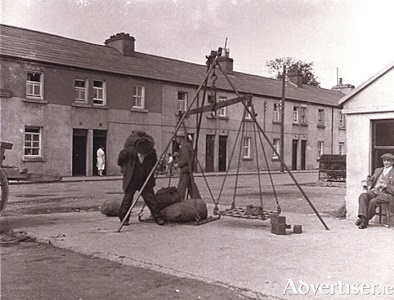The Crane at Woodquay

by Tom Kenny
In the early 19th century, most of the area we see in our photograph would have been under water. Woodquay was so called because of the 150 feet wooden quay that ran the length of it. It was a kind of second docks for the city, attracting a lot of commercial traffic down the river. The Corrib Drainage Scheme in 1852 began to change the face of the space we are looking at, and later, when Steamer’s Quay was built, the area was gradually filled in and reclaimed.
The 1911 Census tells us that the surnames of those living in the newly built Corrib Terrace, which we see in the background, were, starting at Number 1: Collins, Noonan, Burke, Daly, Browne, Gilmartin, Halloran, Gallagher, Cooke, Bayley, Smith, Holley, Meally, Hickey, Walsh, Walsh, O’Brien, Hogan, and Savage.
The main commercial traffic that came in by the river was turf, wood, and timber, all to be sold in the city, but the boats also carried frieze, linen, cloth, broad cloth, butter, corn, grain, honey, and poultry. In earlier times, animals would have been transported into fairs in Galway, but the Anach Cuain tragedy probably put paid to much of that kind of traffic. Woodquay was also the location for selling produce brought in by land from Menlo or the Headford Road.
Goods for sale coming into the city had to pay a toll at various entrances (known as ‘gaps’ ). Toll booths were situated at Forster Street, Merchant’s Quay, Bohermore Gap, West Crane, Railway Gap, Newcastle Gap, and Woodquay. For example the tolls collected at Woodquay for October 1903 amounted to £36 17s 9d, and for April 1904, £48 3s 10d was the figure. Long ago there was a charge of one farthing on each hide of ox, cow, horse, or mare, fresh or tanned. A halfpenny was the toll for every 100 skins of wolves, squirrels, wildcats, or hares. The charge for a horse load of fish was 1d, and for a salmon, it was a farthing.
I am not sure if the hut in our picture was the Woodquay Toll Booth or just a hut associated with the crane, which was used to weigh potatoes and other goods at the regular markets and fairs which were held in the area. The potato market was the most common here, cart loads of potatoes would be drawn up in a row and customers would arrive with a variety of baskets, creels, and ciseáns to carry them home. Sometimes, they were sold by the sack load and were weighed on the scales as you can see.
This photograph was taken c1935 by Kevin Danaher and is one of the many recently put online by the Irish Folklore Commission on a website called duchas.ie
The Old Galway Society is hosting a lecture this evening at 8pm in Victoria Hotel. It will be given by Ronnie O’Gorman on the subject of ‘Postcards from Ballinahinch’ and all are welcome.
